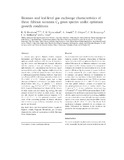Biomass and leaf-level gas exchange characteristics of three African savanna C4 grass species under optimum growth conditions
Date
2009-08Author
Mantlana, K.
Veenendaal, E.
Arneth, A.
Grispen, V.
Bonyongo, C.
Heitkonig, I.
Lloyd, J.
Publisher
Blackwell, www.blackwell.co.ukType
Published ArticleMetadata
Show full item recordAbstract
C4 savanna grass species, Digitaria eriantha, Eragrostis lehmanniana and Panicum repens, were grown under optimum growth conditions with the aim of characterizing their above- and below-ground biomass allocation and the response of their gas exchange to changes in light intensity, CO2 concentration and leaf-to-air vapour pressure deficit gradient (Dl). Digitaria eriantha showed the largest above- and below-ground biomass, high efficiency in carbon gain under light-limiting conditions, high water use efficiency (WUE) and strong stomatal sensitivity to Dl (P = 0.002; r2 = 0.5). Panicum repens had a high aboveground biomass and attained high light saturated photosynthetic rates (Asat, 47 μmol m−2 s−1), stomatal conductance, (gsat, 0.25 mol m−2 s−1) at relatively high WUE. Eragrostis lehmanniana had almost half the biomass of other species, and had similar Asat and gsat but were attained at lower WUE than the other species. This species also showed the weakest stomatal response to Dl (P = 0.19, r2 = 0. 1). The potential ecological significance of the contrasting patterns of biomass allocation and variations in gas exchange parameters among the species are discussed.
Collections
- Research articles (ORI) [270]

